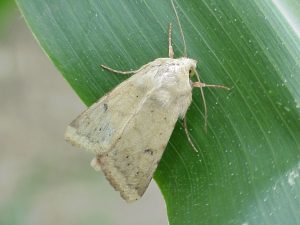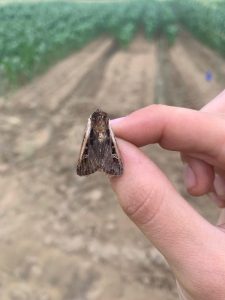Sweet Corn IPM Newsletter – No. 8 – August 12, 2022

Sweet Corn IPM Newsletter No. 8 August 12, 2022
CORN EARWORM NUMBERS MUCH HIGHER
Corn Earworm, Fall Armyworm Moth Numbers Require Higher Spray Frequency
SITUATION
As harvest gets into full swing, some rain and cooler temperatures have improved conditions for corn development in much of the state this week. Moth counts of corn earworm, fall armyworm, and European corn borer have risen significantly in some parts of the state, requiring a more frequent spray schedule to protect silking corn.
European corn borer: Larval feeding injury from just corn borer was not over the 15% control threshold for pre-tassel corn at any of our scouting sites. However, when combined with fall armyworm feeding, the threshold drops to 13% and several farms were over threshold in younger corn (see Fall armyworm below). Moth captures increased in most locations this week. Counts were over the 5-moth threshold for silking corn in Farmington, Lewiston, Oxford, Sabattus, and Wells. All of these sites are also on a spray interval for corn earworm, which should also provide protection against European corn borer. This increase in numbers could indicate a second generation of corn borer is getting started, which we sometimes see when we get lots of warm weather.

Corn earworm: Moth counts have risen significantly in the past week, requiring tight spray intervals for silking corn at most locations to prevent infestation. A 6-day spray interval for fresh silking corn was recommended in Garland. A 5-day spray schedule was recommended for Farmington, and Palmyra. A 4-day spray interval was recommended in Biddeford, Bowdoinham, Dayton, one Lewiston site, Monmouth, Oxford, Sabattus, Wayne, and Wells. A 3-day spray interval was recommended in Cape Elizabeth, New Gloucester, and one Lewiston site. Such a tight interval is unusual in Maine but can happen when we get a shift in weather patterns that move moths into the state.
Fall armyworm: Fall armyworm activity also increased at most sites this week, but distribution remains variable. Trap counts were over the three-moth threshold for silking corn in Biddeford, Bowdoinham, Cape Elizabeth, one Dayton site, Farmington, Garland, Lewiston, Monmouth, New Gloucester, Oxford, and one Wells site. All of these sites are also on a spray interval for corn earworm, so additional sprays should not be needed. Larval feeding damage on leaves and tassels of younger corn was over threshold in several locations, and growers should continue to scout fields not yet silking for injury. When combined with any European corn borer injury found, the control threshold is 13% of plants showing injury. Sprays for feeding damage were recommended in Biddeford, Bowdoinham, Dayton, Oxford, and Wells.

Western Bean Cutworm: Moths numbers continue to be high, ranging from 4 to 53 at our trapping locations. Fields under a spray interval for corn earworm will also be protected against this pest, so additional sprays should not be required.
Squash vine borer: Moths have dropped below the 5-moth per week threshold at all of our locations, except Oxford. So, most fields can take a break from spraying for this pest.
Sincerely,
David T. Handley
Vegetable and Small Fruit Specialist
Highmoor Farm UMaine Extension Diagnostic
P.O. Box 179 Research Lab, Pest Mgmt. Unit
52 U.S. Route 202 17 Godfrey Drive
Monmouth, ME 04259 Orono, ME 04473
207.933.2100 1.800.287.0279
Sweet Corn IPM Weekly Scouting Summary
| Location | CEW
Moths |
ECB
Moths |
FAW
Moths |
%Feeding
Damage |
Recommendations / Comments |
| Biddeford | 50 | 2 | 30 | 31% | 4-day spray interval for silking corn |
| Bowdoinham | 25 | 29 | 17 | 44% | 4-day spray interval for silking corn |
| Cape Elizabeth | 95 | 2 | 14 | 46% | 3-day spray interval for silking corn |
| Dayton I | 9 | 0 | 0 | 4-day spray interval for silking corn | |
| Dayton II | 19 | 3 | 19 | 14% | 4-day spray interval for silking corn |
| Farmington | 6 | 7 | 1 | 5-day spray interval for silking corn | |
| Garland | 2 | 0 | 0 | 0% | 6-day spray interval for silking corn |
| Lewiston | 100 | 12 | 4 | 3-day spray interval for silking corn | |
| Lewiston II | 78 | 7 | 10 | 4% | 4-day spray interval for silking corn |
| Monmouth | 25 | 4 | 4 | 4-day spray interval for silking corn | |
| New Gloucester | 119 | 3 | 28 | 3-day spray interval for silking corn | |
| Oxford | 11 | 22 | 22 | 14% | 4-day spray interval for silking corn |
| Palmyra | 7 | 1 | 0 | 0% | 5-day spray interval for silking corn |
| Sabattus | 39 | 24 | 0 | 5% | 4-day spray interval for silking corn |
| Wayne | 8 | 0 | 0 | 0% | 4-day spray interval for silking corn |
| Wells I | 20 | 0 | 4 | 15% | 4-day spray interval for silking corn |
| Wells II | 44 | 10 | 0 | 26% | 4-day spray interval for silking corn |
CEW: Corn earworm (Only fresh silking corn should be sprayed for this insect.)
ECB: European corn borer
FAW: Fall armyworm
| European Corn Borer Thresholds
Whorl stage: 30% or more of plants scouted show injury. Pre-tassel-silk: 15% or more of plants scouted show injury. Silk: 5 or more moths caught in pheromone traps in one week. |
Corn Earworm Spray Thresholds for Pheromone Traps
| Moths caught per week | Moths caught per night | Spray interval |
| 0.0 to 1.4 | 0.0 to 0.2 | No spray |
| 1.5 to 3.5 | 0.3 to 0.5 | Spray every 6 days |
| 3.6 to 7.0 | 0.6 to 1.0 | Spray every 5 days |
| 7.1 to 91 | 1.1 to 13.0 | Spray every 4 days |
| More than 91 | More than 13 | Spray every 3 days |
Thresholds apply only to corn with exposed fresh silk. Lengthen spray intervals by
one day if maximum daily temperature is less than 80°F.
IPM Web Pages:
http://extension.umaine.edu/ipm/
http://www.pestwatch.psu.edu/sweet_corn.htm
https://ag.umass.edu/integrated-pest-management/
Where brand names or company names are used, it is for the reader’s information. No endorsement is implied nor is any discrimination intended against other products with similar ingredients. Always consult product labels for rates, application instructions, and safety precautions. Users of these products assume all associated risks.
The University of Maine is an equal opportunity/affirmative action institution.
